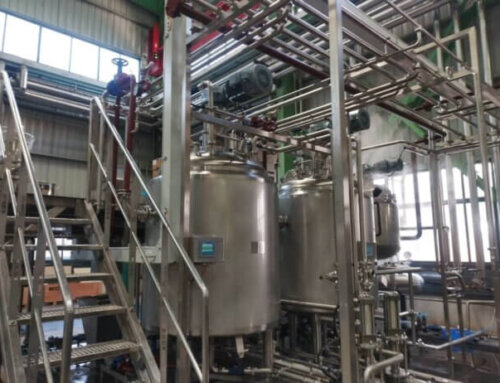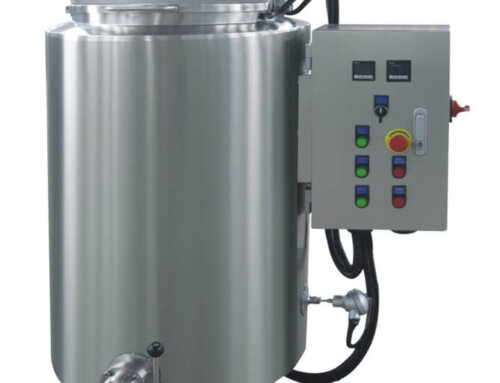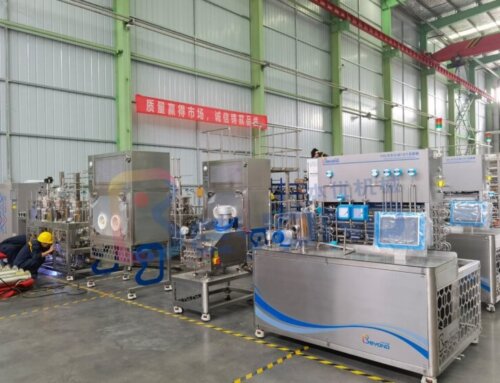The Principle of UHT Processing Technology
The ultra-high temperature sterilization method was pioneered by Burton in the United Kingdom in 1965. Its report shows that the heat lethality rate of bacteria as the temperature increases greatly exceeds the rate of chemical changes in milk such as vitamin destruction, protein denaturation, and browning rate. Studies have shown that within the effective temperature range, the destruction rate of bacteria contained in milk increases by 11-30 times when the heat treatment temperature increases by 10°C. For every 10°C increase in temperature, the chemical reaction rate in the milk increases by 2-4 times, and the browning phenomenon increases by 2.5-3 times, which means that the higher the sterilization temperature, the better the sterilization effect, but the chemical changes caused by the material are small. Experiments have proved that the sterilization process of cow milk takes 150 degrees Celsius as the highest point, and generally uses a sterilization temperature of 135-150 degrees Celsius.
The UHT sterilization of the product is a sufficient intensity thermal treatment of this product, causing all the microorganisms and thermal enzymes in the product to lose activity. The sterilized products have excellent preservation quality and can be stored for a long time at room temperature. Many liquid food and beverage factories can distribute the products to a longer distance and open up new markets.
UHT processing products are often said to be “commercially sterile”. The meaning of commercial sterile is that there is no microorganism that can grow under room temperature storage conditions.
In modern UHT devices, the product is pumped into a closed system. On the way through, the product is preheated, high-temperature treatment, homogeneous, cooling and sterile packaging. Low acid liquid products(PH>6.5) are usually treated for several seconds at 135 ~ 150 ° C. The heating method can be indirectly heated or directly injected or mixed heating. If high acid products (pH is lower than 4.5), it usually heated for 15-30 seconds at 90 ~ 95 ° C. The downstream area of the entire system is sterile after the high-temperature heating section of the system to reduce the risk of replenishment.
The UHT device is fully automated and has four operating stages: SIP( Sterilizing In Place), production, AIC (Aseptic Intermediate Cleaning) and CIP (Cleaning In Place). In the design of a UHT device, security is the primary consideration. It is necessary to completely eliminate the risk of unsterilized products entering the aseptic filling machine. The internal lock program of the control program must provide a complete guarantee to prevent operation errors and program modification.
The relationship between heating temperature and time in UHT sterilization
| Heating Time(S) | Heating Temperature(℃) |
|---|---|
| 5 | 135 |
| 3.6 | 140 |
| 2 | 145 |
| 0.6 | 150 |

UHT Processing Sterilizer Type
Various types of ultra-high temperature sterilization heating systems are shown in the table. The heating medium used in these heating systems is steam or hot water. The steam or hot water is heated by natural gas, coal or oil boilers. Electric heating boilers are only used in rare cases. , Because the conversion rate of the electric heating boiler is only 30%, while the heat conversion rate of other boilers is 70%-80%.
UHT sterilizers that use steam or hot water as the heating medium can be divided into two categories:
The first category is a direct steam heating system. The milk or juice drinks is directly mixed with a certain pressure of steam, during the rapid condensation of the steam, the milk/juice is heated by the heat release of the condensation, and at the same time the product is also diluted by condensate, when it enters the vacuum chamber for flash evaporation, part of the water in the milk/juice is evaporated. In the process and equipment design, the amount of condensed water and the amount of evaporated water are controlled to be equal, so the dry matter content in the milk can remain unchanged, and the preheating and cooling of milk can adopt tube or plate heat exchangers;
The second category is an indirect heating system. The product and the heating medium (hot water) are separated by a stainless steel heat-conducting pipe, and the product has no direct contact with the heating medium.
Whether indirect heating and direct heating, the process conditions are strictly controlled. Before the materials are put in, water is poured into the material pipe system for cyclic heating to reach the sterilization temperature, and the equipment is sterilized for 30 minutes to ensure the aseptic state of the equipment before feeding.
| Heating Medium | Heating Method | Heater Type |
|---|---|---|
| Steam/Hot Water Heating | Indirect Heating | Plate heater/Tubular heater/Scrape surface heater |
| Steam Heating | Direct Steam Heating | Direct Steam Infusion/Direct Steam Injection |
| Electronic Heating | Conductive Heating | Tank Sterilizer |

UHT Sterilizer Application Field
UHT is a food processing technology that almost sterilizes liquid food by heating it above 135 °C (275 °F) – the temperature required to kill many bacterial endospores – for 2 to 5 seconds. UHT is most commonly used in milk production, but the process is also used for other food and beverage products:
- Fresh and reconstituted liquid milk
- Soy milk drink
- Baby food
- Fruit and vegetable juice
- Beverages, such as tea, coffee
- Based on vegetable oils and fats
- Soup
- Sauce
- Fruit and vegetable puree
- Condiments
- Nutrient solution
- Concentrated milk
- Cream
- Flavored milk beverage
- Fermented dairy products(Yogurt, buttermilk, etc.)
- Whey drinks
- Ice cream mix
- Sweets (custard and pudding)
- Protein drinks
- Plant-based milk(oat milk, almond milk, coconut milk, etc.)




